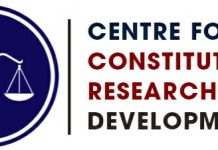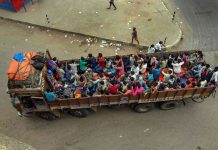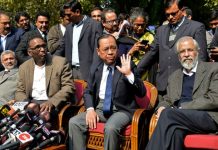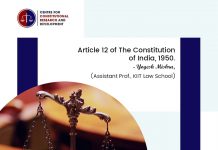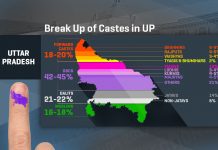INTRODUCTION
Laws pertaining to citizenship are governed under Articles 5 to 11 in the Indian Constitution. But it is to be read along with the Citizenship Act 1955. The recent amendment to the said statue in this aspect is the Citizenship (Amendment) Act, 2019 and it was passed by the Parliament of India on 11 December 2019. The author would like to picturize this article as a rebuttal for the comments made in favor of the Act. This mainly deals with the arguments posed by the Supreme Court jurist J. Sai Deepak. The arguments are in a nutshell to facilitate it for the readers. The proviso inserted under section 2 (1)(b) by the Amendment Bill, 2019 which makes a provision for the illegal immigrants from Afghanistan, Bangladesh or Pakistan, who entered into India on or before the 31st day of December 2014. It states that they shall not be treated as illegal immigrants if they belong to one of the following communities:
- Hindu
- Sikh
- Buddhist
- Jain
- Parsi
- Christian
The issue in turmoil is the above-mentioned proviso. It is tackled in the arguments below.
ARGUMENT NO.1: The above-mentioned religions represent the most prevalent religions in the world. The Indian Government, known for its secularism, recognized all of the religions except Islam despite it being strongly persecuted on the basis of religion. When you contend there is no religious bias involved then you should have clearly included every religion that is practiced in our country. Why the segregation then? This does not come under the ambit of positive discrimination which is permissible under Article 14.
ARGUMENT NO.2: There are 7 neighboring countries to India, namely, Pakistan to the west, China, Nepal, and Bhutan to the north; Bangladesh and Myanmar to the east, and Sri Lanka to the south. Afghanistan is a bordering country to Pakistan but you see, the government is so gracious to include it for granting citizenship. This makes it evident that all the Muslim countries near India were taken “religiously” into consideration for rescuing religiously persecuted groups. This paints a picture that only Muslim Countries carry out religious persecution and that it’s a foreign concept to Non-Muslim countries. This clever inclusion of non-muslims from Muslim countries and exclusion of both Muslims and non-muslims from Non-Muslim countries is only to portray a picture that the community of Muslims was not “targeted” since they have given this second class citizenship privilege to Muslim countries. Thereby, successfully painting the wrong picture and tagging only the Muslim countries for the downfall (religious persecution) of the 5 already mentioned communities. How gracious?? Why doesn’t the Bill talk about religious persecutions that are happening in Nepal, Bhutan, Bangladesh, Myanmar, and China? Why is the Bill silent about Indian-Tamils in Srilanka? Let me update you about the happenings in the other bordering countries.
NEPAL: Persecution towards Christians rose considerably in the region after the Nepalese government introduced anti-conversion laws in 2017. “Any Christian talking about Christianity can be falsely accused of converting now, and there are several such incidents taking place.” It occupies 32nd position on World Watch List of persecuted Christians and has reported a number of recent incidents, including the demolition of a church building and an attack on a Christian run hospital.
BHUTAN: The country is No. 38 in Open Doors’ 2016 World Watch List, an annual ranking of countries where life as a Christian is most difficult. Converts to Christianity endure threats and pressures from village heads and clerics to return to Buddhism. They can pray and worship privately in their homes, but they struggle to meet in congregations and to obtain official permission to do so. Some Christians have reported losing their jobs after their employers found out they were Christian.
BANGLADESH: Bangladeshi Hindus, together with other religious and ethnic minority communities, are undergoing rapid decline. Looting and burning of households, destruction of temples and religious idols, murder, rape, forced religious conversion, illegal occupation of property, extortion, threats to family structures and other soft and hard intimidations are reducing well-to-do households to paupers and forcing this population across the border to India.
MYANMAR: The Rohingyas, as per the UN, have been among the most persecuted group not only under Myanmar’s military regime but worldwide, with the Kachin, who are predominantly U.S Baptists, a close second.
CHINA: Falun Gong, Tibetan Buddhists, underground Catholics, and Uyghur Muslims—face varying degrees of harassment, including imprisonment, torture, and forced religious conversion to atheism.
Why is the Bill then not responding to the persecutions of the above mentioned religious minorities? Why is it not granting second class citizenship to them? If there’s a religious minority in a country and it is being persecuted, a gracious country like India should consider it despite the faith of the community. The state cannot justify by saying a large influx of illegal immigrants will dampen the spirit of the nation when it so ideally came up with the concept of second-class citizenship. These groups are going through the same sufferings as the groups from Afghanistan, Bangladesh or Pakistan. Where and how does the government draw its unique line?
ARGUMENT 3: The Nehru-Liaquat Pact is a standing agreement between India and Pakistan which requires each country to ensure that its minorities enjoy complete equality of citizenship with others and receive treatment identical to that available for other nationals of their country. It is an admitted fact that both countries have violated it in many instances. But the Pact’s violation from the side of India will be seen as fundamentally wrong because of its secularity. Moreover, this cannot be taken as a defense for the execution of section 2(1)(b) as it covers only Pakistan under its canopy and not the other 7 countries. Thus, in the present case, it is futile to the extent when other countries are considered.
ARGUMENT 4: Test of equality is left as a question mark. The refugees from Muslim Countries (Afghanistan, Bangladesh or Pakistan) stand in the same footing as the refugees from other neighboring countries (China, Nepal Bhutan, Myanmar, Sri Lanka). The test is not between refugees from Afghanistan, Bangladesh, Pakistan and Ahmediyas and Shias of Pakistan. If we consider that then we can say it is not a reasonable ground for classification because of its “historical backdrop.” The unclear validation of Ahemediyas and Shias as Muslim communities got nothing to do with intelligible differentia under the principle of isonomy. The basis of classification is among the refugees who are similarly circumstanced. That distinction plays a crucial role in reasonably classifying the communities. Our Constitution and statues have got laws that favor a particular religion in one way and compensate the other in another way for protecting secularism and heterogeneity in the country. The recent Ayodhya judgement can be cited as an excellent example of the same. But so far, no law has ever prescribed a religion affiliated eligibility criteria where the destination of that eligibility is open to all.
CONCLUSION
The fight can be expressed in other words as, “it is not just about claiming second class citizenship rights for Muslims from Afghanistan, Bangladesh or Pakistan but claiming the same for non-muslims from, China, Nepal, Bhutan, Myanmar, and Sri Lanka”. This clever diversion truly deserves appreciation. The Hindutva organizations well planned the bill’s execution but it did not look into its loopholes and the same will not be left unquestioned. What’s the point in keeping your eyes wide open while being blindfolded?
“The views, information, or opinions expressed during [the] series are solely those of the individuals involved and do not necessarily represent those of Centre for Constitutional Research and Development”


